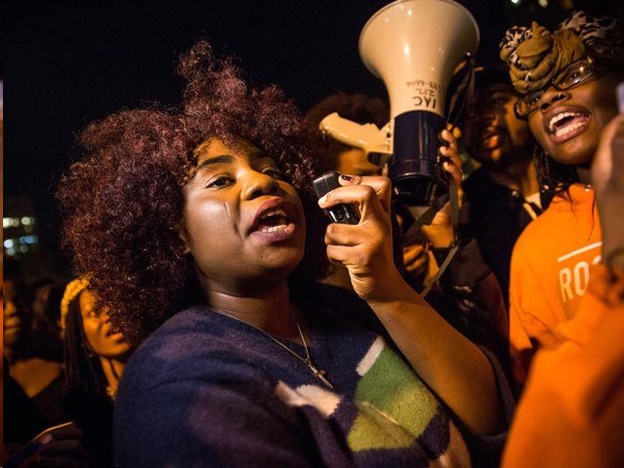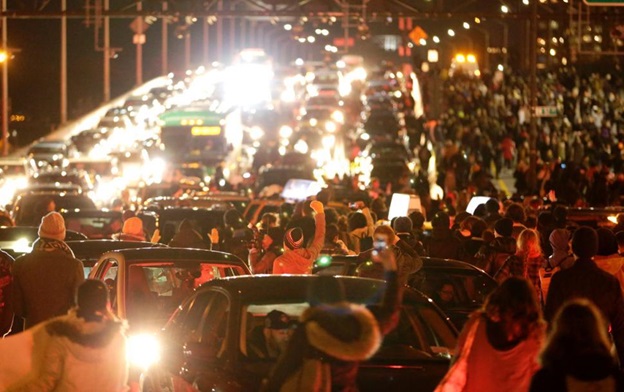The following is one in a series of posts dealing with the wave of protest sweeping the United States following the police murder of Mike Brown and Eric Garner. Other posts in this series include: Burn Down the Prison: Race, Property, and the Ferguson Rebellion,Turn Up Htown: Reflections on Nov 25 Day of Action,The Old Mole Breaks Concrete: The Ongoing Rupture in New York City, and Points for Discussion on Race in the United States from Noel Ignatiev.

1. Work to abolish police and prisons, not to reform them. President Obama has passed legislation to put body cameras on police officers, but this won’t stop the cops from killing black folks. Eric Garner’s murder was caught on camera like many others, and it didn’t save his life. Even worse, this reform can be used against the people it’s supposed to protect: a recent study showed body cameras help police far more often than their victims.
The police and the prison system can’t be reformed, because their basic role is to maintain a racist, unjust, unequal capitalist society–and this requires violence. As Kristian Williams documented in Our Enemies in Blue, police forces developed in the U.S. to capture runaway slaves, crush strikes, and prevent hungry mobs from taking what they needed to live. The system isn’t “broken” when it kills someone like Mike Brown, it’s working just as intended.
Instead of chasing reforms, we should work to abolish police and prisons. It won’t happen all at once, but we can guide our efforts with the catchphrase: disempower, disarm, and disband. We can disempower the police on the streets, by building neighborhood groups that respond to police abuse, and deter them from terrorizing us. We can demand the police be disarmed, taking away their military gear and firearms. And we can work to disband police units one-by-one, starting with the most vicious.

2. Build democratic groups, where we create our own leaders. The old Civil Rights-era leaders are falling back. Jesse Jackson was booed off stage in Ferguson in August, when he tried to pass a collection plate. Al Sharpton was booed when he told everyone to vote for the Democrats. The change is long overdue: these leaders gained prominence only when the movement of the 1970s was defeated, by substituting their own interests for those they claimed to represent, and have stayed in the spotlight ever since.
Now we have the opportunity to build directly democratic groups, events and activities, in which poor and working class people can lead collectively. Yes, the movement needs leaders. But real leaders don’t exist just to stay in power, or make themselves famous. Instead they help the movement develop, and help new leaders to emerge to grapple with new problems. We need leaders from our own neighborhoods and workplaces, who fight in the streets with us, and who make themselves unnecessary over time.

3. Judge people by what they propose and do, not by their identity or rhetoric. This movement is about fighting against the oppression of black people. But at the same time this movement holds promise for everyone: smashing racism and the police will help all poor and working class people, and enrich our common humanity. The movement should welcome everyone who’s really about these goals on as equal footing as possible.
Not everyone thinks this way. With good intentions, many people use “ally” or “privilege” politics to try to correct the inequalities of capitalism and racism within the movement. But most of the time, this just causes those not at the center of these struggles (often, white people) to get involved out of guilt or self-gratification. People constantly think about their own identity and how we can’t work together, instead of seeking out how how we can work together, and what we need to do to win. Instead of uniting us through smashing capitalism and racism, these methods actually reduce us to what we are under these systems. As recent zines and blog posts have argued, this keeps us neurotic, divided, and separated.
Even worse, conservative and middle-class mis-leaders use this guilt to draw lines according to identity, and divide those of us who are fighting in the streets. Guilty, confused “allies” don’t know whether to support the radical black rebellion, or the mis-leaders working to stifle grassroots militancy and shut down debate. When we decide if someone is right based on identity alone, we keep the movement from growing through experience and debate. Instead of judging people this way, we should weigh if their proposals and actions actually contribute to liberating poor and working class black people — and therefore liberating us all.

4. Up-shift from disruptive protests to collective care and power. Taking streets and freeways has provided a huge leap forward for the movement, but all tactics have limits. If we stop building our capacity to fight and sustain ourselves, then even freeway occupations could become a kind of militant reformism, simply causing disruption to get the attention of those ruling over us. To keep building the movement’s strength, we need new ways to assert our collective power, and to take control of more and different spaces, for our own good.
One small step is to support one another when we fight back. Some people weaken and endanger the movement by stopping protesters from confronting cops, damaging property, de-arresting their friends, or moving objects into the street. But the system is violent toward us every day, by definition. Calls for “nonviolence” and “peaceful protest” only perpetuate this condition, by insisting the capitalist state alone can use force–on us. Instead of policing one another, we need to have each other’s back.
We also need to hit back against capitalism and the state, and seize the means to sustain our lives and resistance. Encampments around the world, from Tahrir Square to Occupy Oakland, did this in miniature. Now we have to start thinking and acting bigger. To overcome the police, white supremacy and capitalism, we will have to occupy state offices, city halls, and police stations; take over our schools, workplaces and transit systems; and provide education, health care, transport, goods and services to our communities for free. We can start by building groups with others who’ve been protesting, and with people where we work, learn and live.

5. Deepen our knowledge of race, capitalism and revolution. If police murders aren’t caused by a few “bad apples” or a “broken” system, but are instead the logical result of the system itself, then we need to understand how this system works. The experiences of black people, women and queers, and the working class as a whole, are all fundamentally shaped by capitalism and the state. To learn how this world works, we can explore the ideas of Marx, and many others in the history of revolutions. To learn how to transform it, we can look to communists who opposed authoritarianism and the state, and many other great revolutionaries, while drawing on the history of world revolution.
Past revolutions can show us the general features of how capitalism might be overthrown. Russia 1917, Spain 1936, the high points of the anti-colonial revolutions, and more recently Egypt in 2011, offer lessons good and bad. We know that forms of counter-power tend to emerge, first as small seeds, and then on large scales in moments of crisis. We know internal divisions among the oppressed become barriers to the continued growth of movements, and must be overcome. We know movements can generate new would-be ruling groups, who try to stop the revolution and consolidate class power. We know new forms of social life and creativity tend to emerge in the heat of struggle.
We can draw general lessons like these from past revolutions, but each one is different. What will ours be like?






When I clicked on this post I expected to see another round of identity politics and reformism. I’m glad to see that I was wrong and that there are other voices out there that want to struggle for revolution, voices that are more interested in comrades than “allies”.
Best article I’ve seen on this topic, maybe, ever!
This is a great article! On #5 I think it’s important to add (when speaking about anti-authoritarian communism) the contribution of anarchist ideas – anarchism being by definition anti-authoritarian and anti-state. As the author notes, Spain in 1936 provides a great example of anarchist organizing in Catalonia. Keep up the good work.
There’s some interesting debate on facebook about this document. People have made the claim that this is the revolutionary equivalent of Live Action Role Playing. Could you all respond to this, perhaps by specifying what the purpose of the piece is, as well as who the audience is? Both purpose & audience were called into question on the facebook thread I’m referring to.
Will respond with my own thoughts soon. Personally found the document useful in provoking my thinking in some of the key tasks to be engaging in. Appreciate the thoughtfulness.
Hey Exigence, haven’t seen the Fbook thread you’re talking about (also, not too familiar with LARPing) so I can’t speak on the aptness of the comparison. I can speak to audience and purpose, though.
We thought it would be good to put out several different pieces, speaking to several different levels of experience in the movement and political development. Some of the docs in this series are a bit more complex, making theoretical arguments or speaking to people who are committed revolutionaries. “5 Ways”, in contrast, is more of a “Buzzfeed”-type piece, talking to people who have participated in the recent wave of activity, or who have sympathized and want to help it in some way, but who aren’t revolutionary organizers up on their theory and history.
Our sense is, many people are starting to reflect on the direction and goals of the movement, as the street protests begin to hit limits and/or wear themselves out. From what we’ve seen, most accessible pieces speaking to this critical self-reflection just put forward social-democratic demands, or offer advice on “how to be a good ally”. Thus, the piece’s purpose is to help introduce readers to an alternate set of revolutionary positions emerging within the movement, and to direct readers to further readings to check out, references to look up, and debates or discussions to consider. We hope the timing, content, tone (etc) will make the piece useful.
We distributed literally thousands of these in print, aimed at what we calculated to be the tectonic rifts of the movement. They included contact info to roll with us, or else they stood alone as an intervention in debates we saw happening again and again in the streets and online among people with little connection to the left. As CM is too modest to say, this was one small part of our activity during this period.
I am interested in what alternatives to this activity are proposed by folks calling us LARPers on Facebook. Perhaps Facebook critics take issue with the “live action” aspect? In any case we have been doing a lot of experimenting and are always open to suggestions. Catty swipes from the armchair, not so much.
JF
A strategy piece: http://www.laprogressive.com/protesters-block-freeway/